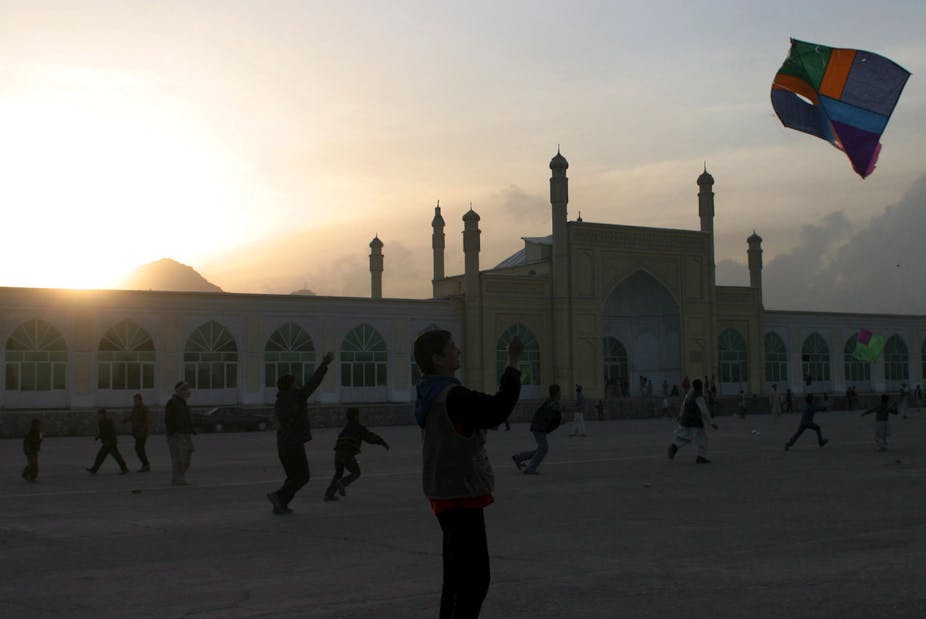As I returned to Kabul last week news broke of the murder, by a suicide bomber, of the cousin of outgoing president Hamid Karzai. Hashmat Khalil Karzai believed he was embracing a young man in the traditional Eid greeting at his home in Kandahar. Instead the 16-year-old boy detonated explosives in his turban.
Eid marks the end of a month of fasting for Ramadan and the three-day festival is an excuse for families to exchange gifts, sweets and to entertain guests. This was my second Eid in Afghanistan and as we drove home from Kabul airport, through streets thronged with boys enjoying the holiday, my delight at being “home” was tempered as I reprised the appalled shock I felt on my first Eid three years ago.
Then and now it seemed as though every single boy child carried a toy gun – Kalashnikovs, pistols, automatics – most of them looking horribly like the real thing as the boys ran and ducked for cover taking aim and shooting at each other as though there was no such thing as war in real life, as though they had come no closer to violent death than my nephews with their toy guns – unlikely given the number of casualties in their short lifetimes.

But in most other places around the world, toy guns are only one of any number of different gifts a boy might receive. Here, however, I see no balls, books or building blocks – just guns. I found the sight profoundly disquieting and sad. When would boys large and small tire of playing at war?
And then for some reason, I glanced up and spotted the other obsession of Afghan boys … kites. Impossibly high, hundreds of metres, they pulled up the corners of my mouth as I tried to see to whose hand they might be tethered. At first they hung, fluttering, hovering, waiting like hawks searching for prey.
Beautifully, brightly coloured, in geometric designs made of taut, fragile paper or plastic attached to a spool of strong string that would slice my hand if I tried to run it through my fingers, they seem to embody joy and freedom. Of course it’s an illusion – they are constrained by the hands of boys large and small who control their flight and movement with extraordinary precision, running along the flat roofs of houses, scrambling over walls and ignoring the shouts of adults.
But for a moment, this red and that blue and yellow kite seemed still and peaceful in the bright blue sky. Then suddenly the smaller red one arced and swooped attacking the other, darting in and out like a boxer, until the string of the loser’s kite broke and it soared off swooping and falling.
A few minutes later I spotted a couple of boys dusty and scuffed having battled for the colourful prize that hung smashed in the bigger boy’s hand. Children’s games – it would be silly to read too much into them, not least because for the most part as I passed the boys smiled, shyly or cheekily, and called: “Salam”, “Eide shma mubarak” or “Howareyou!” before collapsing in giggles.
Bad omens
And yet – it was hard not to see signs and omens. The euphoria of the first round of elections, the pride in the job the security forces had done, the manifest courage and determination of the electorate have been replaced by an aggressive battle between Abdullah who led the first round and Ghani who leads the second.
As they squabble over the auditing of the votes from the second round, it feels as though the country has ground to a halt. The audit by the UN of all the ballots has stalled yet again. It is hard to see how these two men and theirs camps will cooperate in the proposed unity government. And the delays in forming a government will have real and negative consequences.
This year has seen the progressive withdrawal of foreign troops and an increase in casualties at the hands of the insurgents: Between January 1 and June 30, UNAMA documented 4,853 civilian casualties, (1,564 civilian deaths and 3,289 injured) recording a 17% increase in civilian deaths and a 24% overall increase in civilian casualties compared to the first six months of 2013.
More than ever, Afghanistan needs to be planning its future, but it is not even clear who should be invited to the NATO summit on September 5-6. Karzai should now have stepped down but remains in power. And against this background, inevitably the economy weakens. Already in June, truck drivers had protested along the Kandahar-Kabul highway at the insecurity and violence they face.
Because, in spite of the vast sums of money poured into Afghanistan in the past 13 years (much of which went to foreign contractors, but a great deal of which was lost through waste and corruption), the country is going to need more help if the children playing this Eid aren’t going to face a future more filled with guns than kites.

